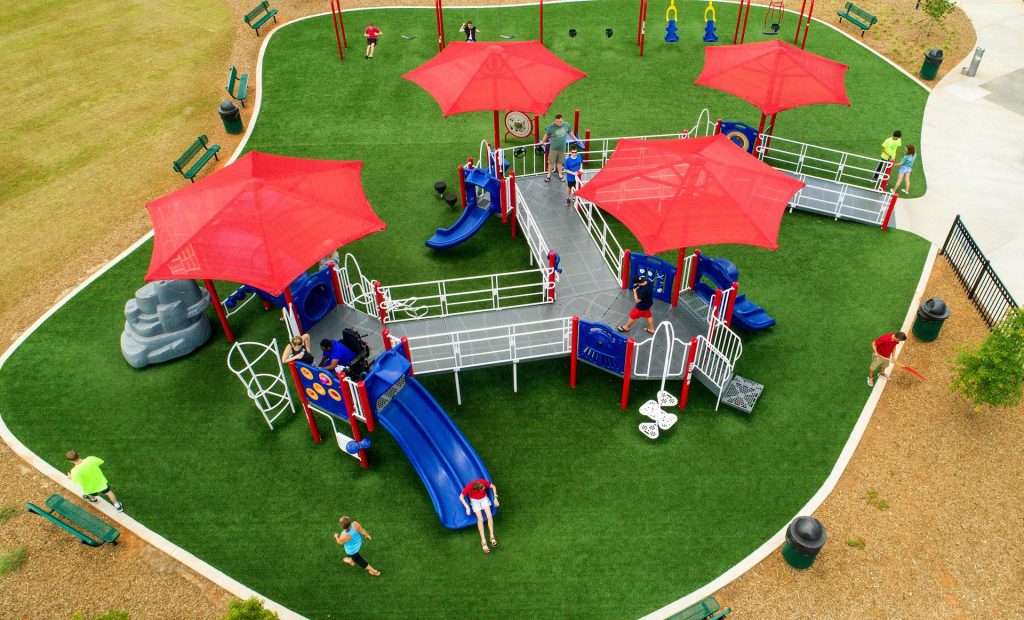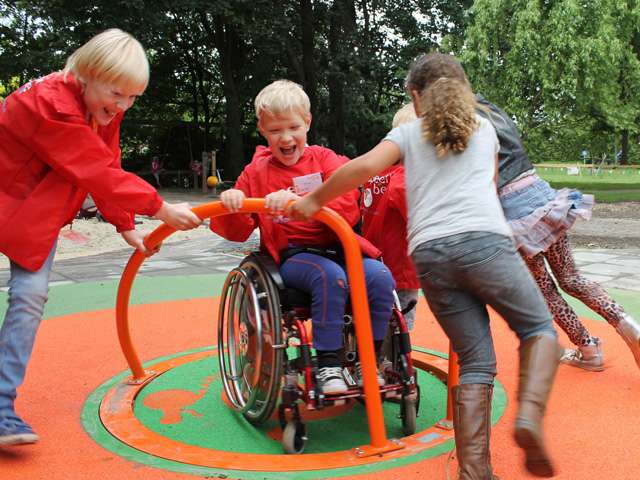Outside of the ADA, here at ACP, we believe that every child has the right to explore and enjoy the joys of the playground from one child to the next, regardless of their abilities. Play is fundamental for a child’s development.
Inclusive playgrounds create a space where every child can feel welcome, no matter their abilities. They’re more than just places to play—they’re where kids learn, grow, and build connections with others in a safe place. These playgrounds allow children to explore, move, and share experiences that help them develop on every level. But what exactly are inclusive playgrounds, and why do they matter to our communities?
What Defines an Inclusive Playground?
An inclusive playground is built to ensure that children of all abilities can play together. Ramps, sensory play areas, adaptive swings, and ground-level equipment create a space where every child can fully participate and feel included.
Inclusive playground design creates a space where every child feels they belong and can enjoy playtime to the fullest. Every child deserves the chance to experience joy, and playgrounds should be a place where that happens for everyone. Kids with mobility challenges, sensory needs, or other developmental differences shouldn’t be excluded. Inclusive playgrounds aren’t just about providing swings and slides—they’re about giving all children a place to grow, connect, and truly enjoy themselves. Creating inclusive playgrounds allows for every child, regardless of their ability, to have the opportunity to connect with their peers in a safe environment to be able to play and learn freely.

The Value of Inclusive Playgrounds
- Promoting Social Inclusion: Accessible playgrounds allow a space to bring kids together in a fashion that traditional playgrounds often can’t accompany. With these environments it allows for children to build lasting relationships that give a sense of community that will last a lifetime. In these moments of play, kids naturally learn understanding, acceptance, and empathy. These playgrounds are about more than just having fun—they’re about giving every child a place to belong.
- Enhancing Physical Development: It’s been shown and proven that playgrounds are essential building blocks that offer opportunities for kids to strengthen their fine motor skills, balance and coordination outside the classroom. For children with disabilities, an inclusive playground provides equipment that’s accessible and safe, encouraging them to engage in physical activities they might not have access to elsewhere. Adaptive equipment, such as swings with harnesses or wheelchair-accessible play structures, ensures that every child can experience the physical benefits of play. These spaces are crucial in not just the element of play, but ensuring that every child’s physical and cognitive development is supported.
- Supporting Cognitive Growth: Beyond physical activity, inclusive playgrounds also provide crucial opportunities for cognitive development. Sensory play areas stimulate curiosity and exploration, with elements like textured surfaces, interactive panels, and musical instruments helping children engage their senses. These features encourage problem-solving, creativity, and critical thinking, all essential for early childhood development.
- Boosting Emotional Well-being: Imagine the joy a child feels when they can participate in the same activities as their peers. Inclusive playgrounds help foster that sense of inclusion and boost self-esteem. When children are welcomed into a play environment that caters to their needs, they feel valued, confident, and capable. These positive experiences nurture emotional well-being and promote mental health in all children.
- Equal Play Opportunities for All: Unfortunately, many playgrounds create unintentional barriers that exclude children with disabilities. On the other hand, inclusive playgrounds ensure that every child has an equal opportunity to play and learn. By addressing the diverse needs of all children, inclusive playgrounds reinforce the idea that play is not a privilege but a right for everyone.
Key Features of Inclusive Playgrounds
When creating a playground that is accessible and functions for all children requires thoughtful design. Here are some key elements that make inclusive playgrounds genuinely inclusive:

- Accessible Design Features: Ramps, wide pathways, and ground-level structures are foundational in ensuring children with mobility aids, such as wheelchairs or walkers, can navigate the playground. This helps the children and allows caregivers and family members to interact more easily with them during play.
- Sensory Play Areas: A playground that offers sensory elements that help stimulate various senses. Elements such as water play-interactive panels/chimes and textured surfaces can engage children who otherwise would not feel inclined to do so due to sensory processing disorders. This sensory-based play allows children with these disorders to feel comfortable and included.
- Adaptive Equipment: The traditional playgrounds we grew up with sometimes fail to meet all accessibility requirements. When you come across an accessible playground, you mainly notice the adaptive equipment, such as harness swings, ground components on an accessible route, or even wheelchair-accessible merry-go-rounds. These additions ensure that every child can play safely and comfortably.
- Safe and Accessible Surfacing: One of the most fundamental and sometimes most overlooked features of any inclusive playground is surfacing. Rubberized or cushioned surfaces help prevent injuries and provide accessibility for children using mobility aids. This thoughtful design ensures that every child is included due to the limitations of the physical environment.
The Broader Community Impact
Accessible playgrounds aren’t just for children with disabilities – they also enrich and unite the community. It provides a safe place for gathering, where families of all backgrounds can come together. A place where children with various abilities form cherish able friendships, build awareness about inclusion, and where accessibility can grow.
When you invest in accessible and inclusive playgrounds, you’re investing in future generations and creating spaces where communities can make a powerful statement. We value diversity and are committed to creating spaces where everyone can thrive. These playgrounds become symbols of what’s possible when we prioritize accessibility, offering lasting benefits for future generations.
Conclusion
Inclusive, accessible playgrounds do more than provide a safe space for children to play- they help build a foundation and starting point for a more accessible and inclusive society. They encourage empathy, physical and cognitive development, emotional well-being, and equal opportunity. As accessibility consultants, we at ACP are passionate about creating spaces that ensure no child is left behind, with most of us being parents as well. Communities that invest in inclusive playgrounds are taking meaningful steps toward a future where every child can play, learn, and grow together.
